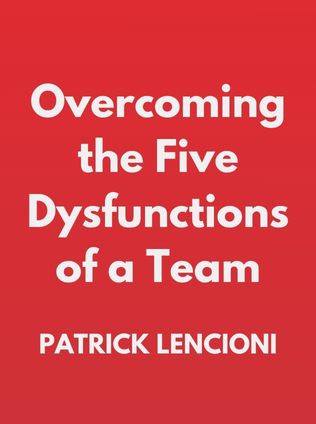
Overcoming the Five Dysfunctions of a Team
A Field Guide for Leaders, Managers, and Facilitators (J–B Lencioni Series)
By Patrick Lencioni
Published 01/2002
About the Author
Patrick Lencioni is a well-respected author, speaker, and consultant specializing in leadership and business management. He is the co-founder and president of The Table Group, a firm that focuses on executive team development and organizational health. Lencioni's expertise in business management and leadership has led him to write numerous best-selling books, with his most notable work being The Five Dysfunctions of a Team. This book, which he later expanded upon in Overcoming the Five Dysfunctions of a Team, has become a staple in the world of business literature, widely read by managers and team leaders aiming to improve their teams' effectiveness.
Lencioni's approach is unique in that he blends storytelling with practical advice, making his concepts both relatable and actionable. His background in management consulting has given him firsthand experience with the challenges that teams face, and his ability to distill these challenges into core dysfunctions has resonated with readers worldwide. Lencioni's work is characterized by its focus on trust, vulnerability, and the importance of cohesive team dynamics, all of which are essential for any successful team.
Main Idea
The central premise of Overcoming the Five Dysfunctions of a Team is that successful teams are built on a foundation of trust. Lencioni argues that trust is the bedrock upon which all other aspects of teamwork are built. Without it, teams are unable to engage in productive conflict, commit to decisions, hold each other accountable, or focus on collective results. The book outlines five key dysfunctions that often plague teams—distrust, lack of healthy disagreements, disunity, fear of accountability, and self-interest—and provides a framework for overcoming these challenges.
Lencioni's framework is designed to help leaders and teams identify and address these dysfunctions. By fostering an environment of trust and encouraging open communication, teams can overcome the barriers that prevent them from achieving their full potential. The book emphasizes the importance of vulnerability in building trust, the necessity of productive conflict in making decisions, and the value of collective accountability in achieving results.
Table of Contents
- Introduction: Creating a Team
- Impairment #1: Distrust
- Impairment #2: Lack of Healthy Disagreements
- Impairment #3: Lack of Unity
- Impairment #4: Fear of Accountability
- Impairment #5: Self-Interest
- Conclusion: Building a Strong Team
Introduction: Creating a Team
Lencioni begins by defining what it means to be a team. He describes a team as a small group of people, ideally no more than 12, who work together toward a common goal. Lencioni emphasizes that not every group of people is a team. A true team puts the collective needs of the group above individual desires. This focus on collective goals is what differentiates a team from a group of individuals who simply work together.
One of the first challenges Lencioni addresses is the natural tendency for people to prioritize their own interests over those of the team. He suggests that the process of creating a team involves specific activities designed to build trust and foster a sense of collective responsibility. This includes getting to know each other on a personal level, engaging in team-building exercises, and creating opportunities for open communication.
Lencioni acknowledges that these activities might initially be met with resistance. Team members may see them as unnecessary or a waste of time. However, he argues that these activities are an investment in the team's future success. By investing time and effort into building trust and fostering communication, teams can avoid the common pitfalls that lead to dysfunction.
Sign up for FREE and get access to 1,400+ books summaries.
You May Also Like
How To Win Friends and Influence People
The All-Time Classic Manual Of People Skills
By Dale CarnegieQuiet: The Power of Introverts
The Power of Introverts in a World That Can't Stop Talking
By Susan CainThe Lean Startup
How Today's Entrepreneurs Use Continuous Innovation to Create Radically Successful Businesses
By Eric RiesWho Moved My Cheese?
An Amazing Way to Deal with Change in Your Work and in Your Life
By Spencer Johnson, M.D.Make Your Bed
Little Things That Can Change Your Life...And Maybe the World
By William H. McRaven



















